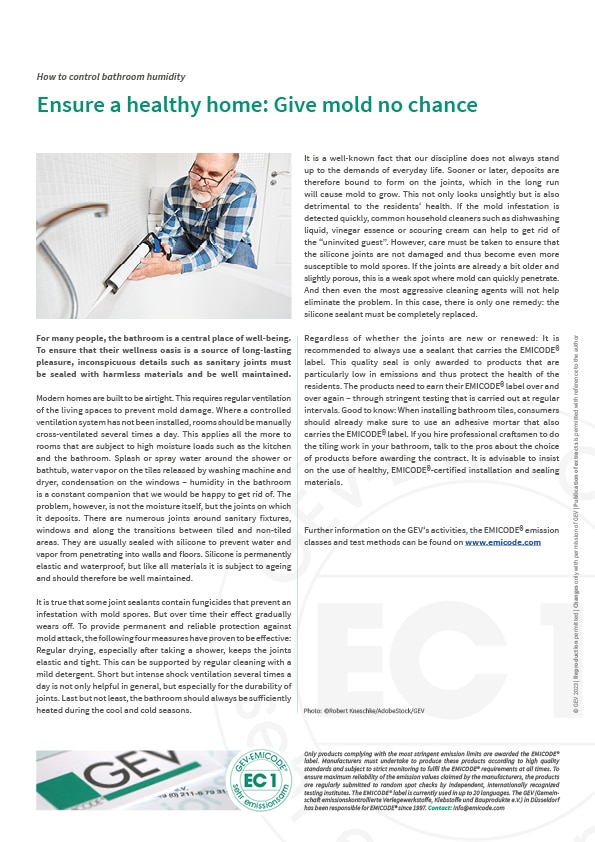Ensure a healthy home: Give mold no chance
How to control bathroom humidity
For many people, the bathroom is a central place of well-being. To ensure that their wellness oasis is a source of long-lasting pleasure, inconspicuous details such as sanitary joints must be sealed with harmless materials and be well maintained.
Modern homes are built to be airtight. This requires regular ventilation of the living spaces to prevent mold damage. Where a controlled ventilation system has not been installed, rooms should be manually cross-ventilated several times a day. This applies all the more to rooms that are subject to high moisture loads such as the kitchen and the bathroom. Splash or spray water around the shower or bathtub, water vapor on the tiles released by washing machine and dryer, condensation on the windows – humidity in the bathroom is a constant companion that we would be happy to get rid of. The problem, however, is not the moisture itself, but the joints on which it deposits. There are numerous joints around sanitary fixtures, windows and along the transitions between tiled and non-tiled areas. They are usually sealed with silicone to prevent water and vapor from penetrating into walls and floors. Silicone is permanently elastic and waterproof, but like all materials it is subject to ageing and should therefore be well maintained.
It is true that some joint sealants contain fungicides that prevent an infestation with mold spores. But over time their effect gradually wears off. To provide permanent and reliable protection against mold attack, the following four measures have proven to be effective: Regular drying, especially after taking a shower, keeps the joints elastic and tight. This can be supported by regular cleaning with a mild detergent. Short but intense shock ventilation several times a day is not only helpful in general, but especially for the durability of joints. Last but not least, the bathroom should always be sufficiently heated during the cool and cold seasons.
It is a well-known fact that our discipline does not always stand up to the demands of everyday life. Sooner or later, deposits are therefore bound to form on the joints, which in the long run will cause mold to grow. This not only looks unsightly but is also detrimental to the residents’ health. If the mold infestation is detected quickly, common household cleaners such as dishwashing liquid, vinegar essence or scouring cream can help to get rid of the “uninvited guest”. However, care must be taken to ensure that the silicone joints are not damaged and thus become even more susceptible to mold spores. If the joints are already a bit older and slightly porous, this is a weak spot where mold can quickly penetrate. And then even the most aggressive cleaning agents will not help eliminate the problem. In this case, there is only one remedy: the silicone sealant must be completely replaced.
Regardless of whether the joints are new or renewed: It is recommended to always use a sealant that carries the EMICODE® label. This quality seal is only awarded to products that are particularly low in emissions and thus protect the health of the residents. The products need to earn their EMICODE® label over and over again – through stringent testing that is carried out at regular intervals. Good to know: When installing bathroom tiles, consumers should already make sure to use an adhesive mortar that also carries the EMICODE® label. If you hire professional craftsmen to do the tiling work in your bathroom, talk to the pros about the choice of products before awarding the contract. It is advisable to insist on the use of healthy, EMICODE®-certified installation and sealing materials.

Photo: ©Robert Kneschke/AdobeStock/GEV
At the transitions from sanitary fixtures to walls and floors, silicone-filled joints provide effective protection against moisture penetrating the building structure. Consumers should make sure that the silicone or grout used carries the EMICODE® label. This guarantees the lowest emissions and thus healthy living.
Do You Have Questions?
If you have any questions on certain topics or want to contact us for another reason, please contact us by phone or email.
Phone: +49 (0)211 843 449 – 01
info@emicode.com
Share article on Social Media:

